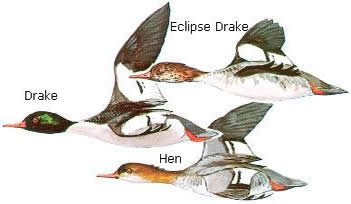Wildlife - Species

Species Specific Regulations
Common Merganser
Licenses: Hunting License required. Migratory Bird Hunting and Conservation Stamp (Federal Duck Stamp) that is validated by the hunter signing the stamp in ink across the face of the stamp
Limits: Please see Migratory Bird Regulations for any game zones restrictions or Limitations.
Common Merganser (Mergus merganser )

Description
This species is larger than the red-breasted merganser, and is one of the largest of our ducks. The drake is a sleek white duck with a green head and sharp red bill.
Average Size
Common mergansers have an average length of 25 1/2 inches and an average weight of 2 1/2 pounds.
Range
The common merganser is found in all four flyways. They are very rare visitors to South Carolina’s coast in the winter months.
Preferred Habitat
During the breeding season common mergansers are found in lakes and rivers bordered by mature forests. It overwinters in large lakes, reservoirs, rivers, coastal bays, estuaries, and harbors. Common mergansers prefer freshwater in the winter while red-breasted mergansers before salt water.
Typical Flock Pattern

Wings

Food Habits
The main food item consumed is small fish, but they will also eat aquatic invertebrates, frogs, small mammals, birds, and plants.
Reproduction
Pair bonds are formed in late winter. Common mergansers are cavity nesters and usually select holes formed by pileated woodpeckers, broken tree limbs, and hollow tops of standing trees. They will also occasionally use rock crevices, old building, holes in banks, hollow logs, or borrows. They readily accept manmade nest boxes. The female prefers cavities with nest material, but will occasionally add some herself. She then lays 6-17 creamy eggs.
Sound
The only call seems to be a startled croak.
Behavior
- Flocks move in "follow the leader" style, low over the water.
- It is one of the last to migrate south.
- No apparent territorial behavior. Females especially social on breeding grounds.
- During winter months, flocks in the hundreds are possible.
Citations, Publications and Literature
U.S. Fish & Wildlife Service, Federal Duck Stamp Office Presents: North American Waterfowl (Adobe PDF file)
Mallory, Mark and Karen Metz. 1999. Common Merganser (Mergus merganser), The Birds of North America Online (A. Poole, Ed.). Ithaca: Cornell Lab of Ornithology; Retrieved from the Birds of North America Online
South Carolina waterfowl hunters 16 and older are required by state law to obtain a state migratory waterfowl permit and Migratory Game Bird permit. Both permits must be in the hunter's possession while hunting or transporting legal waterfowl. A state waterfowl permit is included with the Lifetime Senior, Lifetime Gratis and Disability Licenses. S.C. residents who hold a Lifetime Senior or Lifetime Gratis License are not required to have a Migratory Game Bird permit.
National Migratory Bird Harvest Information Program (HIP)
The waterfowl permits and HIP permits are available from select DNR offices and from hunting and fishing license agents.
